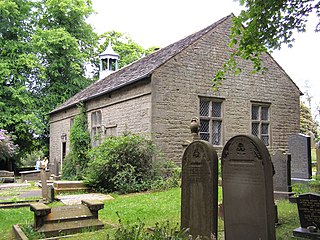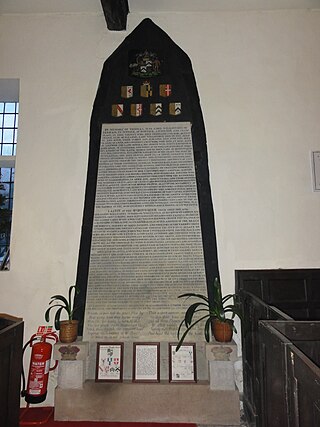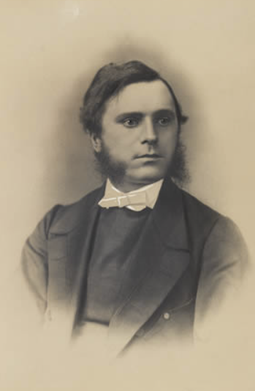
Bank Street Unitarian Chapel is a Unitarian place of worship in Bolton, Greater Manchester, England.

Bank Street Unitarian Chapel is a Unitarian place of worship in Bolton, Greater Manchester, England.
Bank Street Chapel has its origins in a congregation established by the ejected Presbyterian minister Richard Goodwin at Great Bolton, Lancashire, in 1672. He began preaching there after taking advantage of the Royal Declaration of Indulgence which relaxed the stipulations of the Five Mile Act 1665. [1] Bolton had gained a reputation as a bastion of Puritanism during the English Civil War, when the attacking Cavalier forces called it the Geneva of the North, supposedly because of its similarities to the Calvinist stronghold of Geneva, although historian Malcolm Hardman notes that the sobriquet was "more out of irritation than accuracy". [2] On his death in 1685, Goodwin was succeeded as minister by John Lever, who had also suffered ejection. Throughout this time, the congregation was based at a meeting house on the corner of Deansgate and Mealhouse Lane, which later became the Woolpack Inn. [1] [3]
Information varies regarding Lever's successor, Robert Seddon, who came from Prestolee [4] and had attended the University of Cambridge. [5] He had been ordained in 1854 and was a minister at Gorton before at some point moving to either Langley [4] or Kirk Langley, [5] both in Derbyshire. It was from there that he was ejected in 1662. Edward Baines says that he began preaching in Bolton in 1688, [4] although his role as minister is agreed by other sources to have begun in 1692. [1] [3] He bought a house at Windy Bank, which later became known as Bank Street. He donated that to the congregation but died according to one account just before it opened as a chapel in 1696. [1] Franklin Baker, who later became a minister at Bank Street, says Seddon ceased being minister in 1695. [3] However, Baines says he lived to see the opening of the chapel and was the first minister there but died in 1696, [4] and Herbert McLachlan, a Principal at the Manchester Unitarian College, says he donated the building in either 1695 or 1696 and died in 1699. [5] He was succeeded by his nephew, Samuel Bourn. [4]
The congregation, which by the 1720s amounted to over 1,000 people, [6] initially followed the precepts of Presbyterianism but moved to Unitarianism around the time of the short ministry of Thomas Dixon junior, prior to Philip Holland taking charge. Hardman notes that the Bank Street ministers had "long been wrestling with problems of human morality in relation to divine grace" up to that time and that Dixon's changes caused a break-up among the congregation that "since 1672 [had been] the spiritual home of many of the old mercantile families of the neighbourhood". Some members left to join a congregation at Duke's Alley because of these changes. [1] [7]
In 1789, the incumbent minister, John Holland, the brother of Philip, established both a Sunday school and a library at the chapel. [8] The congregation split in 1821 due to disagreements concerning appointment of a minister. While some people stayed at Bank Street, others moved to an alternate place of worship until in 1843 the two sides united once more. [9] As at Renshaw Street Unitarian Chapel in Liverpool [10] and at Cross Street Unitarian Chapel in Manchester, the congregation was predominantly liberal in politics and socially elite. They were also tight-knit: the alliances formed by marriage, mutual business interests and friendships were numerous and notable. One minister - Franklin Baker - married into the Crook family, who were members of the congregation. [11]
The original Bank Street building, from Seddon's gift in the 1600s, was T-shaped but was replaced in 1856 by a George Woodhouse-designed structure, incorporating three pew doors from the original. [12]
The building today carries a plaque commemorating its association with Eagle Street College, a group of local people who admired Walt Whitman and counted the chapel and its school among their meeting venues.
According to the book published on the occasion of the chapel's bicentennial in 1896, the early ministers of the congregation were: [13]
The General Assembly of Unitarian and Free Christian Churches is the umbrella organisation for Unitarian, Free Christians, and other liberal religious congregations in the United Kingdom and Ireland. It was formed in 1928, with denominational roots going back to the Great Ejection of 1662. Its headquarters is Essex Hall in central London, on the site of the first avowedly Unitarian chapel in England, set up in 1774.

Cross Street Chapel is a Unitarian church in central Manchester, England. It is a member of the General Assembly of Unitarian and Free Christian Churches, the umbrella organisation for British Unitarians.

William Gaskell was an English Unitarian minister, charity worker and pioneer in the education of the working class. The husband of novelist and biographer Elizabeth Gaskell, he was himself a writer and poet, and acted as the longest-serving Chair of the Portico Library from 1849 to his death in 1884.

Chowbent Chapel is an active Unitarian place of worship in Atherton, Greater Manchester, England. It was built in 1721 and is the oldest place of worship in the town. It is a member of the General Assembly of Unitarian and Free Christian Churches, the umbrella organisation for British Unitarians. The chapel was granted Grade II* Listed status in 1966.

Rivington Unitarian Chapel is an active place of Unitarian worship in Rivington, Lancashire, England. It was founded in 1703, although its congregation dates to 1667. It is designated as a Grade II* listed building with some restoration in 1990, and hs ongoing preservation.
John Seddon (1725–1770) was an English Dissenter and rector of Warrington Academy.

Franklin Baker was an English Unitarian minister.
George Harris was a British Unitarian minister, polemicist and editor.

Hugh, 15th Baron Willoughby of Parham was an English nobleman and hereditary peer of the House of Lords. He was born in 1713, the eldest son of Charles Willoughby, 14th Baron Willoughby of Parham and Hester, daughter of Henry Davenport of Little Lever and Darcy Lever, near Bolton. Hugh Willoughby's father died on 12 June 1715, aged 34, and the infant Hugh Willoughby became the 15th Baron Willoughby of Parham. He could not take his seat in the House of Lords until he reached the age of 21.
Samuel Bourn the Elder (1648–1719) was an English dissenting minister. His maternal uncle was Robert Seddon, who became minister at Gorton, Lancashire and Langley, Derbyshire, where he was silenced in 1662. Seddon sent Bourn to Emmanuel College, Cambridge, which he left in 1672. His tutor was Samuel Richardson, who taught that there is no distinction between grace and moral righteousness and salvation is dependent upon the moral state. It does not appear that Bourn accepted this view; his theology was always Calvinistic and, although he regretted deflectors from that system, he was no hunter of heretics.
Thomas Dixon was an English nonconformist minister and tutor.
John Seddon (1719–1769) was an English Unitarian minister.

Philip Holland was an English nonconformist minister.

Joseph Crook was a Liberal British Member of Parliament (MP) for Bolton.

Charles Clement Coe was an English Unitarian minister and writer who advocated non-Darwinian evolution.
John Ashton YatesFRSA was a British Whig politician and railroad investor.
Sir Thomas Baker was a Unitarian minister and Mayor of Manchester, England.
Richard Goodwin was a minister of religion who instigated nonconformist worship in Bolton, Lancashire, in 1672, creating a congregation that later became known as Bank Street Unitarian Chapel.

John Yates (1755–1826) was an English Unitarian minister, for over 30 years at the Paradise Street Chapel in Liverpool. He was an abolitionist, a supporter of radical causes, and a member of the Roscoe circle of progressives.
Notes
Citations
{{cite book}}: |work= ignored (help)